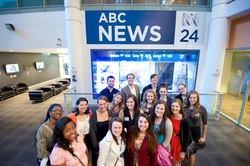
On Thursday, May 23, Dr. Andy Selepak and I took 16 students from our ethics classes to the Australian Broadcasting Corporation. What we heard was music to our ears.
The ABC is a well-regarded public broadcaster that serves this nation of about 24 million people. It is a full-service network along the lines of the BBC. But unlike the BBC, which derives its revenue from a license fee paid by television set owners, ABC gets its money from the government in three-year contracts.
The ABC has some 1,000 journalists nationwide, according to our tour guide, Gordon Lavery, the network manager for ABC's 24-hour news channel, which launched three years ago.
What I've seen of the ABC in three weeks is a high-quality broadcaster that puts to shame much of what is seen in the United States. I was especially struck last night (watching while grading papers) how the network covered nonstop a town-hall-style meeting led by Prime Minister Julia Gillard in western Sydney even though the 41st meeting of its type could not have generated much news. CNN would have cut away in a minute, bored.
But what really impressed me about the ABC was hearing from Mr. Lavery how the network's journalists are expected to be multi-platform journalists.
ABC journalists handle radio, television and online. The broadcaster has worked hard to make its website more robust, and it expects its journalists to write for online as well as create packages for radio and for television. Yes, some journalists are stronger at one form than another. But there is not such thing as just a "radio" or a "television" journalist.
Increasingly, journalists in the states are expected to be fluent in more than one platform, too.
Thus, people like Dr. Selepak and several others have been pushing to continue to convert our shiny new newsroom back home, the Innovation News Center, into a truly integrated, multi-platform newsroom. Some of us have been agitating for a revolution in our curriculum to match.
The ABC newsroom offers an incentive to integrate our platforms with all deliberate speed.
See pictures for more.
The ABC is a well-regarded public broadcaster that serves this nation of about 24 million people. It is a full-service network along the lines of the BBC. But unlike the BBC, which derives its revenue from a license fee paid by television set owners, ABC gets its money from the government in three-year contracts.
The ABC has some 1,000 journalists nationwide, according to our tour guide, Gordon Lavery, the network manager for ABC's 24-hour news channel, which launched three years ago.
What I've seen of the ABC in three weeks is a high-quality broadcaster that puts to shame much of what is seen in the United States. I was especially struck last night (watching while grading papers) how the network covered nonstop a town-hall-style meeting led by Prime Minister Julia Gillard in western Sydney even though the 41st meeting of its type could not have generated much news. CNN would have cut away in a minute, bored.
But what really impressed me about the ABC was hearing from Mr. Lavery how the network's journalists are expected to be multi-platform journalists.
ABC journalists handle radio, television and online. The broadcaster has worked hard to make its website more robust, and it expects its journalists to write for online as well as create packages for radio and for television. Yes, some journalists are stronger at one form than another. But there is not such thing as just a "radio" or a "television" journalist.
Increasingly, journalists in the states are expected to be fluent in more than one platform, too.
Thus, people like Dr. Selepak and several others have been pushing to continue to convert our shiny new newsroom back home, the Innovation News Center, into a truly integrated, multi-platform newsroom. Some of us have been agitating for a revolution in our curriculum to match.
The ABC newsroom offers an incentive to integrate our platforms with all deliberate speed.
See pictures for more.
 RSS Feed
RSS Feed